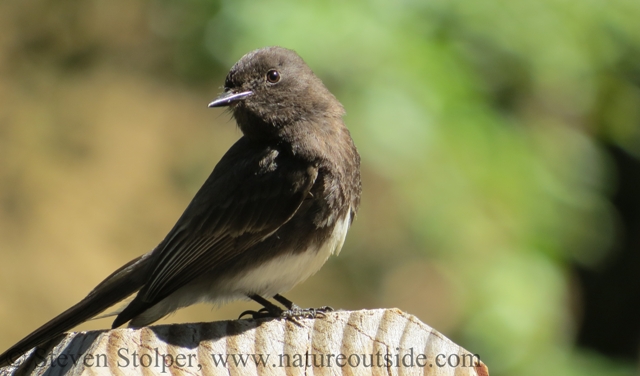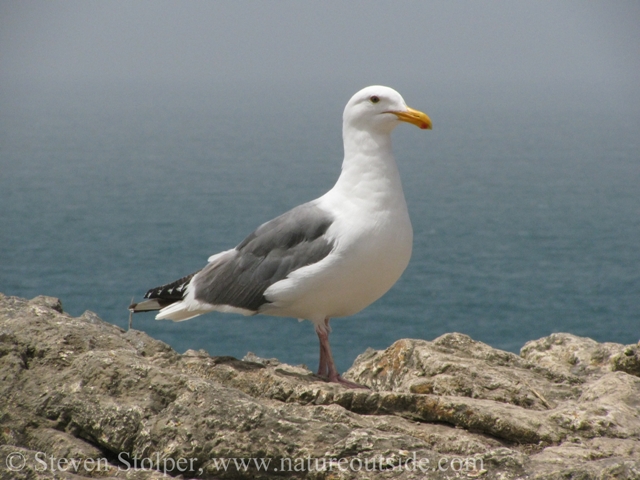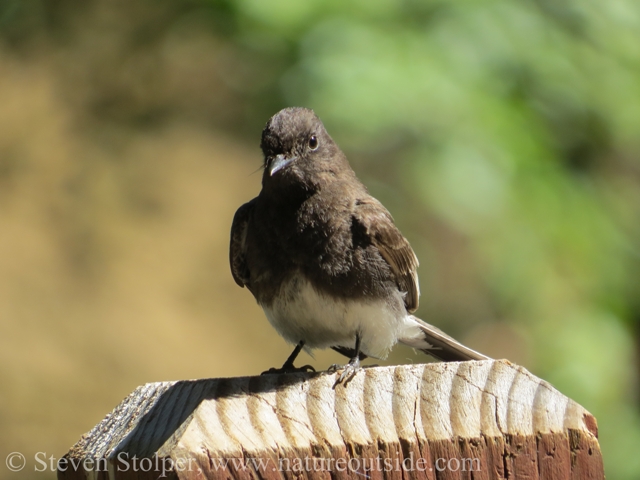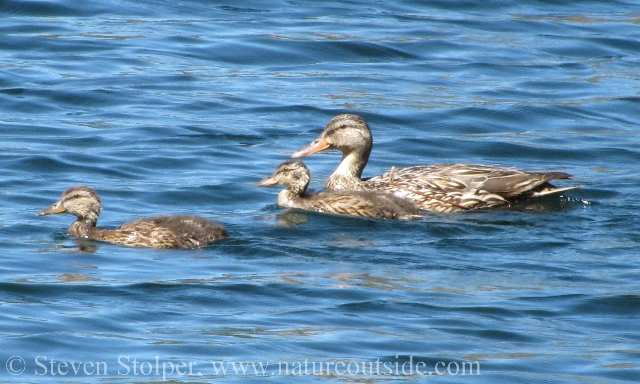
After three years of severe drought, Mother Nature is making up for it all in one go.
Prolonged heavy rain often gets me thinking. And the question that springs to mind this time is: Where do birds go during a storm?
Sometimes simple questions provide insight into what we take for granted. They make us pay attention to the world around us. And this question, like many in nature, has a subtle answer: It depends on the type of bird!
Seabirds

California Gull (Larus californicus) perched on a bluff overlooking the Pacific Ocean
Some of the larger seabirds can ride out a storm at sea. But most of the smaller ones seek shelter on land. If you observe seabirds along the coast that typically fly far from land, it can signal an approaching storm beyond the horizon. Gulls and pelicans can fly out of the storm’s path. Their flight or absence can also warn of an advancing storm front.
Land Birds

The Black Phoebe (Sayornis nigricans) catches insects on the wing. It is more vulnerable to prolonged heavy rain.
I’m sure you’ve observed that light rain does not affect most birds. Their feathers shed rain and trap air against their bodies to help keep them warm. But heavy rains prompt them to seek shelter in bushes and trees. They remain motionless and conserve energy much as they do at night.
Prolonged rain means the birds will run an energy deficit. At this point they must feed regardless of the consequences. Seed eating birds tend to do alright, as do birds such as robins that hunt worms flooded out of the soil. But insect eating birds and raptors can suffer greatly. Their prey becomes inactive in heavy rain and this can become a crises. Birds can and do die of hypothermia from many days of stormy weather.
Timing is Important
Smaller animals have a larger surface area to mass ratio. So they lose heat faster. Smaller birds, particularly chicks, are vulnerable to prolonged rain. Heavy rains during breeding season can be more damaging to the bird population than at other time of the year. This is also true because chicks have smaller energy reserves to draw upon than adults.
Ducks

Ducks, like these Mallards, benefit from flooded fields.
For some birds, heavy rain is an opportunity. Flooded fields provide new territory for ducks. And ducks can exploit them with fewer predators prowling around. In addition, a good wet season means lots of insect larvae for the ducks to eat.
An Opportunity for Us Too

Looking for birds in the twilight after a heavy rain. I was backpacking in the Rocky Mountains.
Where birds go and what birds do during a storm depends on the type of bird and the severity of the rains. I like to go birding just after a heavy rain to enjoy the explosion of foraging activity as birds make up for lost time.
Try doing this and let me know what you see. Leave a comment below.
More Birds on NatureOutside
Owl Class – The Harry Potter School of Bushcraft
Birds Think You are a Scary Dinosaur
What we can learn from a Harrier’s Butt
If you enjoyed this article, you may like others in the Nature Section or the Parents Corner.



Thank you for sharing. It is something that needsto be thought of. Where do you go? If away from home or a comfortable spot, what would you do?
Thank you for providing this info. We have a bird nesting in our pine tree with 3 eggs. The constant stormy weather we’ve had this spring has me concerned for her. And that has led me to wonder about all birds during heavy rain storms.
Susan, birds are good at coping with periods of stormy weather. So it’s likely the birds in your pine tree will be fine. You’re lucky to have a nest nearby to observe!
We have lots of various birds in the woods surrounding our house. Today is a gray, rainy day and I got to thinking where the birds go when it rains. They sure are good at concealing themselves. Thank you! Can’t wait to see all those beautiful birds when the Sun comes out.
Rosie, it’s a gray, rainy day where I am too. When the rain stops, I look forward to seeing all those hungry birds reappear to forage for food.
Today May 26, 2019 After the rain the birds was chirping really loud and beautiful. I’m grateful to learn survival from birds.
Charrann, I agree that nature has a lot to teach us. It rained where I am, too. I expect to see a lot of foraging activity now that the rain has stopped.
We too, in the mid central area of the US, have had much rain this season. As I sat this morning, watching a pair of red birds at our feeder, I marveled at their persistence in the rain.(and therefore sought for answers in this web sight). God has so provided for their way of living. They just keep on singing rain or shine. We should do likewise!
Brenda, you point out a good lesson we can learn from nature. Rain or shine, if we persevere things will be alright.
Hi Brenda,
Remember this song:
All things bright and beautiful All creatures great and small.
All things wise and wonderful, The Lord God made them all.
Each little flower that opens, Each little bird that sings.
He made their glowing colors, He made their tiny wings
—
The Lord takes care of us, and likewise we take care of His other beautiful creatures.
Blessings.
Bradford
P.S. ‘Twas raining all day on the East coast, and not a bird was in sight. In searching to find out where they go I stumbled on this site, and saw the various comments.
I put up a popup to keep seed dry during rain Now it seems all birds have gone I had lots of birds Everything ate together squirrels birds deer What happened ?Is it because of popup birds left ?Please help I feed sunflower seed and bird seed pieces of fruit. Area cleaned daily .Help
Delores, I am not familiar with the term “popup.” So I am going to assume this is a small canopy placed over your feeder.
It is important to keep your seed dry and mold-free. So it is good you are protecting your feeder from the rain.
There could be a number of reasons why birds are not visiting in great numbers. If you live in the northern hemisphere, it is the end of summer. Birds are finishing rearing their young and even beginning to migrate. Another possibility is that they cannot see the feeder from above, or are concerned they don’t have an escape route because of the popup. Or, if the popup is a bright color, it’s movement in the wind may frighten birds. Or perhaps they need some time to get used to it.
You can try a number of experiments. One is to remove the popup and see if the birds return. Another is to leave the popup for a month or two and see if they return.
Good luck!
Hi dear want to let you know that I am disabled and I’m in my bedroom most of the time but my bedroom on the second floor has a roof that extends out. Out this window I see and feed sparrows. What a wonderful thing to see them every morning or afternoon eating it’s amazing. Mother nature is amazing their community and how comunicate with each other gives me somewhat of a spiritual insight as to what else is happening in this world in this universe and I often wonder where do they go when it rains or where do they sleep at night do they stay together in the branches or when the weather’s really bad do they go into shelters and if they do what shelters do they go in thank you so much for sharing your information with me I’ve never done this before and I’m absolutely in love with Birds now thank you
Beverly, thank you for your wonderful comment. You may want to consider investing in a pair of binoculars to get “closer” to the birds. There are several wonderful books you may want to read that tell you more about birds’ lives and what it is like to be a bird. In no particular order:
What It’s Like to Be a Bird: From Flying to Nesting, Eating to Singing – Sibley
The Sibley Guide to Bird Life and Behavior – Sibley
Bird Sense: What It’s Like to Be a Bird – Birkhead
Have fun observing and learning about birds!!
I have replanted a forest where people had previously cut down all the trees to make charcoal. To my awe and delight lots and lots of birds have relocated to my small forest. It’s raining and I was just now wondering where all the birds are! Thank you very much for this enlightening article.
Evelyn, I’m happy to hear about your forest. More of us should plant bushes and trees that benefit wildlife. I’m glad you enjoyed the article.
You didn’t answer the question you only said depends on the bird ok
Where do Blu-ray’s and cardinals go for shelter when it rains
Birdman, there are thought to be as many as 10,000 species of birds. So I am not able to list every one and describe its habits. Blue jays mostly eat seeds. But they are also known to eat caterpillars, grasshoppers, and beetles. Cardinals eat insects, seeds, and berries. A bird’s diet gives us clues to what it does when it rains. Where it shelters depends on its local habitat.
I bought a new bird feeder which is made of heavy clear plastic with a dome on top to protect the seeds from getting wet. The feeder is pretty big but after two days of installing it none of the birds are using the new feeder. I eft the new feeder but put the old feeder back which I created myself. The birds are back using my created feeder which is very close the new one but have not used the new feeder.
Could the feeder be too close to the ground?
Madeleine, it can take several days for birds to find the new feeder. See what happens when the seed runs out in your “old” feeder. Do the birds switch over?
It is possible that the new feeder is too low, or too exposed. If it is substantially bigger or smaller, it may attract different species than the ones using your old feeder.
I suggest you play with the height, position, and contents of the new feeder. I’m certain you will arrive at a solution.
Thank you Steve. You are right, the new feeder is too low, I will have put it higher. After 4 days the birds are still using the old feeder except for one bird which came to the new feeder, grabbed a seed and quickly left. I placed the feeders close to a rhododendron so the bird feel safer that way.
Thank you for the information!
You’re welcome, Carl!
Thank you for the information! Could you tell me the name of the small brown bird in the first picture?
Freesia, thank you for your comment. The bird is a Black Phoebe (Sayornis nigricans). It is a type of flycatcher and catches insects on the wing. There is another picture of this bird in the “Land Birds” section of the article.
It’s been really storming here and my little robins just flew out of the nest 2 days ago. I hope they will be ok.
Karen, the fledglings are probably sheltering nearby and Mom is bringing them food. I’m sure they will be fine.
I have a baby dove sitting in the windshield wiper area on my car! It is storming heavy rain with gusty up to 60 miles per hour. Will he be ok?
Can I do anything for him?
Lisa, Spring is the time you often find fledgling birds on the ground, seemingly abandoned. But it’s mother is usually nearby and feeding it. When the weather turns bad, I expect the fledgling to follow its parents to shelter.
My advice is do nothing right now. You don’t want to take it away from its parents. Wait until the storm arrives, and then check to see if the bird remains on your windshield. If it is still there, you could consider taking action. Right now, you can research animal rescue organizations near you so that you will have someone to call for advice if you see the bird out in the storm.
We saw a fledgling chirping sparrow this morning. The parents are feeding it and it hops and tries to fly here and there. There is woods and bushes nearby. A VERY hard rain just came thru and I am worried about the little guy. It was pouring rain, big drops. It started out just a few drops then went into an absolute downpour. Do they know to seek shelter in the bushes when they are new fledglings?
We saw a fledgling chirping sparrow this morning. He was hopping around and trying to fly here and there. The parents were feeding him. There are woods and bushes close by. It started sprinkling rain then turned into a downpour for about 15-20 minutes. Very hard rain. Will he know to seek shelter in the bushes? We’re worried about the little guy.
Diane, it’s great that you are concerned for the fledgling. Rain is a common occurrence and birds have always had to deal with it. The young bird will remain with its parents and they will look out for it. Nothing is ever guaranteed. But the best thing you can do is let the parents look after their young. When the rain subsides, and it is daylight, you can check on it to be sure it is alright.
Thank you. I’ll keep a look out for it. It was in my yard across from my driveway. (Sorry about the double post. My internet went out about the time I hit post and I didn’t think it went thru)
I just came in an he’s there and fine. ☺️ I just watched the yard to see if the parents flew down to the ground and sure enough they did so I got my binoculars and saw him and he was fine and eating!
We’ve had more cool bird experiences this year than ever. I’m in Alabama and this is actually the first yr we’ve gotten a Wood Thrush. So that was exciting plus getting to see the fledgling chirping sparrow was awesome!
I’m glad to hear everything worked out, Diane!
Thanks for this article Steve! Very interesting. It’s been raining quite heavily here in London tonight and as I was feeling cosy in my home I felt bad for the birds having to face the unpleasant conditions. So I wondered where they go to shelter, whether trees provide adequate rain cover or whether they go somewhere else I hadn’t thought of. It was reassuring to read your article and your replies to the comments, reminding me how well adapted they are to survive.
I’m glad you enjoyed the article, Amy. Feathers are truly remarkable and help birds cope with unpleasant weather. They insulate them from cold and provide some measure of water resistance. The spacing of the barbs prevents water from flowing through or sticking to the surface of the feather. So songbirds can handle most rainy conditions “like water rolling off a duck’s back.” 🙂
Wonderful. Nature is the best 🥰
https://xkcd.com/1434/ for the most cogent discussion
That is too funny!! The Xkcd science cartoons crack me up. I never knew Xkcd did a “Where do birds go?” cartoon. Hilarious!
Thank you. We are so appreciative of your information!
I’m glad you enjoyed the article, Mona and Bruce!